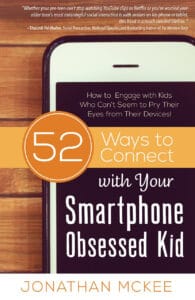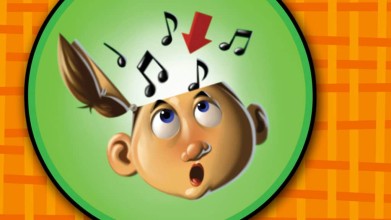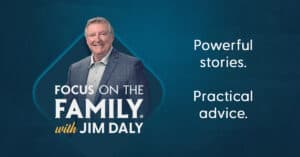Jonathan McKee: You gotta look at the future, and you gotta realize that, you know, this kid when they turn 18 years old, could go to a college dorm. They could go to an army barracks. They could go live in little, you know, uh, an apartment with their friends. And they’re gonna be making those decisions on their own. They’re not gonna be calling you up and asking you whether or not they can watch that TV show or not. And the question we need to ask ourselves is, have we equipped them to start making those decisions, or have we made every decision for them?
John Fuller: Jonathan McKee has some great ideas for helping you and your teen put the screen down and spend meaningful time together. This is Focus on the Family with Jim Daly and thanks for joining us. I’m John Fuller.
Jim Daly: You know, John, I had so much fun with the boys growing up, and I think we had accidental success when it came to screens, ’cause we, we didn’t give them phones until they were, like, I think Trent was 17 and Troy was 15.
John: Mm-hmm.
Jim: And a lot of people, a lot of experts, talk about, that’s the first good thing to do, delay it as long as possible.
John: Mm-hmm. Right.
Jim: But we did camping every summer. We just did outdoorsy stuff.
John: Mm-hmm.
Jim: It was so much fun. But I don’t know about girls. I don’t have girls. How about you?
John: Ah, the, the girls, uh, all of our kids kind of waited until they were 15, 16, 17. A- actually, a daughter traveled to the UK without a phone at age 19, so-
Jim: That’s crazy. (laughing)
John: And the girls, I think the girls leaned into relational things-
Jim: Wow.
John: … more than the guys, I think is, is what you’re asking about.
Jim: Yeah. It is pretty good. And today, you know, this is probably the number one thing parents are mostly concerned about, especially parents of teens, pre-teens, is when do we give them a phone? How do we go about managing that with them and teaching them how to manage it? So this will be very good, basic stuff about things to think about when you’re putting technology in the hands of your kids.
John: Yeah. And, and maybe you’re thinking it’s too late. I, I can’t figure out how to get back. Jonathan McKee is gonna offer some great insights. Uh, he is a social researcher and a popular speaker. Uh, you can hear him on our Entertainment Review podcast, the Plugged In Show. Uh, he’s written a number of books. And the one that forms the basis for today’s conversation is 52 Ways to Connect with Your Smartphone Obsessed Kid: How to Engage with Kids Who Can’t Seem to Pry Their Eyes from Their Devices. Uh, learn more about Jonathan in this terrific resource. We’ve got the details at focusonthefamily.com/broadcast.
Jim: Jonathan, welcome back. We’ve had, you’ve been on the program, I don’t even know, five, six, eight times.
Jonathan: Yeah, something like that. (laughs)
Jim: (laughs) Well, we appreciate it. I mean, you really have studied, uh, you know, technology. You’ve done the research.
Jonathan: Mm-hmm.
Jim: You know, one thing, John, as you just said there, what we have to do as parents, and we can start here because it’s an important place to start, we need to make sure we’re modeling it well. We can be the addicted phone user. Right?
Jonathan: Yeah. No, absolutely. I mean, this, I guess this book could appropriately be titled, uh, 52 Ways for Smartphone Obsessed Parents to Connect with Their Smartphone Obsessed Kids.
Jim: Well, people, I mean, it’s just, it’s got a grip.
Jonathan: Yeah. This is a family thing.
Jim: We’re looking at it and, and all people are kind of, it’s like a magnet, right?
Jonathan: Yeah.
Jim: We just go there for information, for news, for quick hits on things that we’re interested in. In some ways, it’s really good. It’s the abuse of it that we’re talking about when it’s overly used. So let’s move that into, uh, kind of the power of social media and how kids, particularly young people-
Jonathan: Mm-hmm.
Jim: … are really attracted to it. Um, speak to the allure of social media and why, why teens and pre-teens are so engaged with it.
Jonathan: Yeah. No, I mean, this is one of those things where obviously, it’s drawing a lot of people in, young people and, and people our age alike-
Jim: Yeah, no.
Jonathan: … you know? But for young people, the- they’ve grown up with it. I mean, you know, they’re a digital native, man. I mean, they grew up with this thing practically in their hand. I mean, we still live in a world where the average young person gets this device at around 10 years old. Even though most research out there is saying, wait till high school, you know, it, it’s tough as a parent. Let’s be honest, it’s tough because, uh, if you wait that long, your kid’s gonna come home and be like, “Mom, dad, all my friends have smartphones.”
Jim: (laughs)
Jonathan: And I’ve been in arenas, like in middle school arenas, like talking with seventh graders and literally, I’ll be like, “Hey, everybody pull out their phone,” ’cause like, I always kind of want an inventory and see. And literally, every kid, every kid pulls out their phone. So if, if your kid says that, it might be true. What is the allure, you ask? I mean, it is, let’s be honest, I mean, how many of us, we ourselves are like, you get on something like a TikTok or a YouTube and you can just scroll. You could watch for three seconds. Nope, scroll-
Jim: Well it’s information, it’s humor, it’s engaging.
Jonathan: It’s fast.
Jim: It’s a fast hit. You don’t have to be on it long.
Jonathan: And it’s like, I mean, for, you know, for us old folks, it’s like the go… We got our own The Gong Show. We can gong-
Jim: (laughs).
Jonathan: … everything within three seconds, and boom, go right onto the next thing. And so, I mean, you’re like, “Nope, nope. Oh, that’s good. Uh, I like that.” And then, and of course, what we don’t even realize is happening behind the scenes is, you know, there’s algorithms noticing exactly how much time we’re spending watching. We don’t even have to click like. If we spend a little more time watching a certain thing, they’re like, “Ah, he likes funny puppy videos.” Before you know it, you’re gonna see a lot of funny puppy videos. You know, if you like wiener dogs, you’re gonna see a wiener dog.
Jim: He found my weakness.
Jonathan: If you like Frenchies… Yeah, there it is.
Jim: (laughs)
Jonathan: I mean, you know, so, so there is the allure ’cause there’s people making lots of money on it. And they’re banking on the fact that, “Hey, if we pump this guy more Frenchie dog videos, he’s gonna watch it longer.” And that’s what they want.
Jim: And you can apply, apply any topic to that, you know-
Jonathan: Yeah, absolutely.
Jim: … even to things that are damaging.
Jonathan: Yeah.
Jim: In that regard, what’s the average age of children right now receiving smartphones?
Jonathan: Uh, about 10 years old.
Jim: 10 years old. I mean, that’s a lot of power in the hand of a 10-year-old.
Jonathan: Yeah.
Jim: In that way, how do we not, uh, be reactive but proactive and help, helping to teach our young kids, you know, how to manage something like that, or our preteen teens?
Jonathan: Yeah, yeah. I mean-
Jim: You know, what, what do we do to be proactive?
Jonathan: Yeah. That was kind of the energy, you know, that was kind of the motive behind this book, was the fact that, you know, let’s be honest, we all… Most of us have devices in our pockets as adults. Our kids, by the time they get to high school, they’ve got devices in their pockets. And instead of coming across as this, “Hey, these things are bad,” you know, “These things are evil,” hey, I mean, my gosh, these things help us, you know, get places. These things help us connect with grandma. These things help us do lots of positive. Our Bible app is right there, you know?
John: Mm-hmm.
Jonathan: You can have devotions, you can have all kinds of good stuff on there. Instead of saying, this is a bad thing, what if we not only modeled, but what if we were very proactive about knowing when to have the thing out and when to just put it in your pocket. And so this book is full of a lot of ideas. Sometimes using devices to connect and sometimes knowing when to put a device away, not necessarily going up to a camping trip where there’s no Wi-Fi. Sometimes just in the day in, day out, the dinners, you know, uh, little things we do every day where we don’t have our devices out and we’re just actually enjoying face-to-face communication.
Jim: You know, teenagers, like adults, we can come up with some great arguments even at, even at 14, 15. And we say something like, “Mom, dad, hey, at least I’m doing this and not something worse. I could be a drug dealer, I could be, you know, whatever, fill in the blank. But I’m only looking at YouTube stuff or Snapchat, or whatever.”
Jonathan: Yeah, yeah. You know, it is funny because young people, this is huge for them. And if we are talking to them about, “Hey, that thing is bad,” they’re kind of like, “Oh, what planet are you from, mom and dad?” I mean, everybody’s got… Why would everybody have one if it’s so bad? I mean, you know, shouldn’t the surgeon general be talking about this? Well, that’s the funny thing. The research is out there now, and there is a lot. I mean, if you Google, are smartphones safe for 13 year olds? My guess is you’re gonna find a host of articles of people talking about how it affects your sleep, how it affects, you know, your grades, how it affects, you know, so much of this stuff. The more time you spend, especially on social media, you’re gonna find it for young girls, it really affects their self-esteem big time. Anxiety goes up. For young boys, it affects attention span. You know, hilarious, my daughter and I go skiing, and when we go skiing, we’re on one of those quad lifts. And okay, so I’m in California, we’re an hour and a half from Tahoe. And so we get to go skiing, you know, whenever we feel like make an hour and a half drive. We get up there, we go and skiing, and these two snowboarders jump on a quad lift with us. And as we’re going up, these two kids are basically complaining and whining about the book, The Great Gatsby. And my daughter and I are laughing. My daughter’s grown. She’s actually a high school admissions counselor. So she talks to high school kids all the time. I’ve grown up talking with high school kids. We’re laughing. They’re like, “Great Gatsby, it’s lame. I can’t believe they want us to read this book.” And my daughter is like, “Oh, really? You have to read it for school, you have to write a report?” And she’s all, “Well, did you like the book?” And both of them were like, “Well, I haven’t read it.” And we’re like… And so we immediately were like, “Well, well, what book is your favorite book?” And they’re like, “No books.” I’m not making this up.
Jim: Yeah.
Jonathan: These are two high school kids. I go… Well, and she starts saying, “Well, what about this?” And she starts naming books ’cause she loves reading. And she’s like naming, “What’s the favorite book you ever read?” And one of the kids literally goes, “Diary of a Wimpy Kid.” And we’re like-
John: Ooh.
Jonathan: “Okay, how about one without pictures? You know, is there, is there like, is there a book?” And he’s like, “I have actually never finished a book.” He says he’s never finished a book. This is a high school kid. As my daughter and I get off that ski lift, we’re not only cracking up, but we’re like, “This is our future.”
Jim: They’re paying your social security. (laughs)
Jonathan: Yeah. This is our future, two kids who have never read a book. Now, I know that’s not every single kid out there, but this is one of the, just things that’s happening in this world where we’re scrolling through stuff and we’re learning, “Hey, if I’m not entertained in three seconds, scroll to the next thing.”
Jim: Mm-hmm.
Jonathan: And with young men, this is huge. With young girls, the “Wow, she’s prettier than me.”
Jim: Mm-hmm.
Jonathan: “How come I’m not that pretty?” These feelings of, of poor self-esteem and anxiety, this is the world we’re living in. And if we could start conversations with our kids about these things, ’cause when they’re asking us, “Hey, at least I’m not dealing with drugs.” Yeah, don’t get in that argument. Start talking about these important things and, and, and bring these subjects up. And that’s one of the things a book helps you do. It’s helped you find ways to discuss this topic without preaching, without coming down on them, but actually asking their opinion and listening to them.
Jim: Mm-hmm. Jonathan, one of the examples that you use is creating a family docking station.
Jonathan: Yeah.
Jim: I love that idea. The only thing I question, you say, “Put it in mom and dad’s bedroom.”
Jonathan: Yeah, yeah.
Jim: Uh, okay. Well, I put it in the kitchen, but, but I, our kids did kind of, you know, trick us many times-
John: They figured-
Jim: … to go down-
Jonathan: Well, see, and that’s the thing.
Jim: … at one in the morning. So they’d have to come into the bedroom. So I get it.
Jonathan: No, it’s funny you say, the kitchen. True story. I’m out here recording one of the broadcasts I’ve done here.
Jim: (laughs)
Jonathan: I connect with some childhood friend, my wife and I go connect with her and her husband, and they’re like, “Oh, what were you talking about?” And we brought this subject and the docking station came up. She goes, “Oh yeah, we used to have one in our kitchen, but that didn’t work.”
Jim: Right.
Jonathan: I’m like, “Really? Tell me about this.” And she tells the story of literally hearing a noise in the middle of the night, husband going down the stairs with a baseball bat-
Jim: (laughs) Intruder.
Jonathan: … clicking on the lights. And the teenagers sitting there and they’re like, “What are you doing?” He’s like, “I just wanted to see if they liked this post that I sent out earlier.” So literally, in the middle of the night, was so curious that snuck down the kitchen.
Jim: Yeah.
Jonathan: So I say the bedroom, and I mean, I even joke with parents and, and parent workshops, I say, “You know, stick it right there in the bedroom, and then crush a light bulb on the floor right there in front of it, right there. And so that way, you’ll hear when they’re sneaking into your bed, you know?
Jim: (laughs) No, no, that’s not endorsed by Focus on the Family.
Jonathan: No, exactly, exactly. Don’t do that. But the thing is, ’cause they’ll do it anyway, they’ll walk right across the glass, but, uh-
Jim: They’ll put their shoes on.
Jonathan: It’s the, the point is, find a place where, where… You know, almost all the research out there says, “Hey, if you’re gonna give your, if you’re gonna give that 10-year-old a device, which they don’t recommend you do, at least collect the devices.” Not just smartphones, iPads, computers, that old phone that you forgot you have, that your kid has hidden in their room because they’ve got it connected to the Wi-Fi. And guess what? It’s just like a smartphone. Get all those devices out of the bedroom at night. And if that means having a docking station in your master bedroom closet where you put all the phones, including yours at night, it’s amazing.
Jim: That’s a good idea.
Jonathan: It’s amazing. Now all of a sudden at night, you could re… Those two kids in the ski lift might actually read a book, you know, because-
Jim: No way.
Jonathan: … there’s nothing else to do.
Jim: (laughs).
Jonathan: If they can-
Jim: Not until they’re 20. (laughs)
Jonathan: If they’re just scrolling through their phone, they’re never gonna read a book. But if there’s nothing else to do at eight o’clock… I remember with our kids, we literally would be like, “Well, you guys can either go to bed or you can stay up and read, your choice.” And they’d be like, “Read.”
Jim: Well, let’s talk about that.
Jonathan: Yeah.
Jim: How do you fill that time if you’re gonna, you know, try to persuade them to move to some other activity. You used cookie dough.
Jonathan: (laughing)
Jim: Now, this is funny, you know?
John: I like this idea.
Jim: How to use cookie dough to get your kids off the screen? What, what was that about?
Jonathan: Well, well, see, in, in our house, we’re very food motivated as McKees.
Jim: (laughs)
Jonathan: Uh, if, if you can’t tell in my profile-
Jim: Most of us are.
Jonathan: … I could stand up and show the profile shot. But, uh, I tell you, we love food and food actually works. Now, here’s the brilliant thing about cookie dough. When cookie dough happens in our house, first of all, it always starts to debate because I start immediately eating dough and my son would always start eating dough. And then my wife, Laurie, she’d be like, “Oh, stop. That’s bad. You’ll get some salmonella.”
Jim: It’s got raw egg in it.
Jonathan: Uh, yeah. I’m like, “I don’t… Come on. Who, who has died from cookie dough? I wanna know right now.” So there’s always that dynamic going.
John: (laughs)
Jonathan: But the other thing that’s funny is, we all start literally getting our hands on cookies. And when you have your hands on food, the same works with pizza, the same works with wings, you find a greasy food or oil food-
Jim: (laughs).
Jonathan: … then you can’t have your phone in your hand because you’ve got messy food in your hand. And the other thing that happens with food is you end up laughing and talking. And we would find that when we got cookie dough out, when we got pizza out, when we did some of these things, that it just kind of catalysted conversation. And that’s what we were always looking for, is anything that just kind of allowed us to just be able to sit back. Plus, we always had a, a rule in our house that was like, no tech at the table.
John: Mm-hmm.
Jonathan: So it just kind of became one of those things where like, if we even we’re doing cookie dough, everyone kind of drop their phones aside, we go to the table and we just start talking and laughing.
Jim: Yeah, which is good. Another example you used in the book was, uh, I think a call with grandma.
Jonathan: (laughing)
Jim: So how did, how did you use a call with grandma to have your kids put their phones down?
Jonathan: Well, well, there’s all kinds of different things that I think, I remember in the book was, uh, I think my, my mom, um, for Mother’s Day once said, “You know what I want for Mother’s Day? I want help in my garden.” And so we were all like, you know, “Of course.” We’re like, “Oh, okay, we gotta do this.” So what we did is we all showed up and she was like, “Let’s do this.” And we went out and we planted like bulbs, and we planted stuff in the garden for her. And of course, we were out there, we had our hands in dirt and all kinds… Again, when you’re occupied, and yeah, I know sometimes kids, “Well, let’s take a picture of what we did so we can post it.”
John: Mm-hmm.
Jonathan: But it was one of those times where we ended up talking with grandma, hanging out with grandma. And my parents are, God bless them, they’re so involved in my kids’ lives that they would be hanging out for meals and stuff all the time. So they actually loved being with grandma.
John: Mm-hmm.
Jonathan: But it was a time where we knew this was devoted to her, so nobody came with their phones out and stuff. We were like, “Hey, how can we serve Nana? How can we do this?” And we knew that digging in the garden and helping her put bulbs, well, guess what? We’re all laughing. We’re having fun. You know, we’re doing this together. These are the types of things. And you know, it’s gonna look different for each family. For our family, that was something where they knew Nana was a priority. They knew that this was a time to have phones in the back pockets and we had a good time planting bulbs with grandma.
Jim: Mm-hmm.
John: Good stuff from Jonathan McKee today on Focus on the Family with Jim Daly. And, uh, we’re talking about, uh, just some of the great ideas in his book, 52 Ways to Connect with Your Smartphone Obsessed Kid. And, uh, we’d invite you to get a copy of the book from us at focusonthefamily.com/broadcast. And Jonathan, uh, you shared a story about your dad who made an, a rather significant impulse purchase, um, to help you as a family.
Jonathan: Yeah.
John: And you said that was the only impulse purchase you ever saw him.
Jonathan: Well, the only impulse purchase that Tom McKee has ever made in his entire life. My dad is one of those guys who, you know, we would be at the grocery store and we’d be like, “Oh, that Snickers bar looks good.” And he’d be like, “Well, son, let’s go home. Let’s make a budget. Let’s pray about it for a month.” And, you know, I mean, this, this was, this was what we grew up with, you know? I mean, everything was very… And, and my mom, you know, very, you know, “You know, if you invested that Snickers bar money, do you know if you threw that in Vanguard because there’s no fees, uh, that…”
Jim: (laughs)
Jonathan: You know, she would… That, that’s what we lived in.
Jim: Now I know why you like cookie dough.
Jonathan: A- A- absolutely.
Jim: (laughing).
Jonathan: Because it’s cheap. And, um, so the thing is, you know, uh, there was never splurges. Well, there’s this one time where it just so happened this, this next door neighbor came to us and said, “Hey, um, we’re moving. We have this hot tub that we haven’t touched in, you know, in years. Uh, there’s a deck all built around it. If you want all that, we’re gonna clear it out before we move. We don’t even… You can just have it.” And my dad looked at me and we said, the very common McKee phrase, “If it’s free, it’s for me.”
Jim: (laughs)
Jonathan: And so we went over there and we started taking apart this deck. The spa looked pretty rough. We didn’t know, but so we thought, “Well, let’s do the deck first.” So we spend the whole Saturday building this deck with this giant hole in it, you know, I mean, it, you know, for a spa. And we get it beautiful. And then we go over to get the spa. The spa was a little rougher than we thought, you know, this thing. And as, as we go and we start to move it, it literally falls apart. It disintegrates.
Jim: Mm-hmm.
Jonathan: It just… And so my dad goes over and he looks at this deck, giant hole in it, and, uh-
Jim: (laughs)
Jonathan: … we’ve spent the whole day building and everything, and he grabs his credit card and he goes, “Boys, get in the car.” And we look at each other, we’re like, “What? And what is that strange card he has in his hand that we’ve never seen before?”
Jim: (laughs)
Jonathan: And we go and we pull up to this… Literally, it was called Cal-X Spas. I still remember it like it was yesterday. And we walked in, there’s all these hot tubs. I don’t know the difference between a hot tub and a spa, folks. I’m sure somebody will tell us in the comment section. But we go in and literally, salesman comes up, “What do you need?” And my dad pulls out a tape measure. So, you know, and he names whatever, “84.” You know, names whatever the diameter was to fit that hole. And the guy goes, “Yep, this one right over here.” And he hands him the credit card and goes, “We’ll take it.” Next thing you know, this thing is being delivered at our house, it’s full of water, and we are like, “Yes, we’ve got a hot tub. This was-”
Jim: And a clean one. (laughs)
Jonathan: A clean one with a brand new deck. Well, something crazy happened. That purchase that he made, he was probably thinking, “Oh man, I can’t believe we did this, whatever.” Whenever we tell the story, he goes back, he goes, “You know what was crazy?” He goes… Something happened because every night right around bedtime, he would put on a bathing suit and he’d go out and he’d go, “Well, you guys can go to bed, or, uh, well, you can come out in the spa with me if you want.” And we’re like, “Well, let’s go to the spa then.” It’s like the reading thing. Right? Well, it’s either bed or… So we’d go out there with him, we’d just be under the stars and we’d just talk. He goes, “You know, I think I discovered this by accident.” He goes, “But we could never get you guys to say more than a word or two. We’d ask you what’s going on, fine, you know. How’s it going? Good. You know, and then, ‘Okay, gotta go.'” He goes, “But when I got you in that spa, you wouldn’t shut up.”
Jim: Mm-hmm.
Jonathan: He goes, “Best purchase I ever made.”
Jim: Yeah. And that’s good. That’s a, a smart way to do it. Find an activity you can do where-
Jonathan: Yeah.
Jim: … your kids open up. Yeah, totally.
Jonathan: An arena where communications cultivate, whatever that looks like.
Jim: You, you have another one that is a good one, I think. And that’s to, uh, be engaged, like with their playlist, talk to them.
Jonathan: Yeah.
Jim: You can’t grade it. Do not grade their playlist.
Jonathan: (laughs)
Jim: But you’ve got to, to engage it. Yeah. Let’s listen to some of that.
Jonathan: Yeah, yeah.
Jim: I mean, we do a lot of board games and card games. So Jean got into that where we would, everybody would take a turn-
Jonathan: Yeah.
Jim: … playing a song on the little tower, you know, and, and it was really good. And it does give you a chance.
Jonathan: You get insight into their life-
Jim: Yeah, totally.
Jonathan: … and to their taste.
Jim: But speak to that idea and coach the parents on how to do that well.
Jonathan: Yes, yes.
Jim: (laughs) Because you, you could fumble that one.
Jonathan: Well, one of the important things you said is to not, you know, criticize, or not… And that, that’s the thing that tends out, right? You walk in and your kids are sitting there scrolling through, you know, social media, and immediate thing is, you know, you go, “What are you guys looking at?” You know, “Is that appropriate?” Or “How much time has that been on the device today?” What if instead when you saw them scrolling through social media, you’re like, and, and they’re laughing, go, “Hey, hey, show me. Is that… What’s so funny? Hey.” You know, like, you know, and it’s really the attitude you bring to it. Because if you’re like, “Show me,” like, “What are you… Are you looking at something bad?” No, that’s not what I’m talking about. Like, “Hey, what’s so funny? Hey, what’s the funniest video you’ve ever seen?” You know? And all of a sudden, you let them be the expert and show you. You can do the same with a playlist. So the playlist, it, it seems like a different thing, but we used to go on car rides. And one of the things we do is we said, “Okay.” And my, uh, wife’s family is from Arizona, we’re in California, is a 13-hour drive. And we would always make that drive ’cause it was cheaper than five of us flying. And we said, “Okay, everybody put together your playlist.” And every one of us put together a playlist and the rule was, no headphones. You had to listen to other people’s playlist. Well, the kids loved it when we got to their playlist. And we loved their playlist, except for my son’s. We never liked his playlist, but we liked everybody else’s playlist. So, but we, we always had a fun time. And it was funny, and we’d make fun of my son’s playlist. So I’m just kidding.
John: (laughs)
Jonathan: Because screamo the whole time. No, I’m just kidding. But we, it was just one of those times where literally, we got to know the taste of our kids. Still to this day, my daughters and I, we will share playlists back and forth. And my youngest, Ashley, man, she’s got… Everybody admits, she’s got the best playlists. So we’re kind of like, “Oh, is that good? Yeah. That’s one of Ashley’s.”
Jim: The difficulty though, is when you do hit some rough patches, how do you go about, uh, “Boy, tell me more about that? Why do you like that?” Asking questions is what you recommend. And that’s fair game, especially, you know, there can be some pretty bad stuff.
Jonathan: Well, and, and that of course, I’d say it depends on the age. Right? You know, you gotta a 10-year-old, you know, all of a sudden, bringing out some music that they shouldn’t be listened to with a 10-year-old, that’s very right, right then, right now, “Hey, sorry. Nope. Eh.” It’s that simple. As they get older, I think you, one of the things we’ve talked about before on this broadcast is letting them make some of those decisions as they get closer to getting out of the house. So it really does depend on their age. But in every situation, I think instead of just coming down and saying, no, I think having an opportunity to get to the why behind it.
Jim: Mm-hmm.
Jonathan: Hey, tell me more about that song-
Jim: Yeah, yeah.
Jonathan: … what’s that song is saying?
Jim: No, it’s so true.
Jonathan: Hey, I like that. And start asking some questions.
Jim: It kind of leans into another item you put in the book. And that is, uh, to take a don’t, “don’t fast.” Uh, what do you mean by a don’t fast-
Jonathan: Yeah.
Jim: … for the parents?
Jonathan: Well, it’s interesting, this happened as I started talking with a lot of dads who I think kind of struggle with the same thing I struggle with, and that was that they would end up being in lecture mode a lot. And they found themselves saying, no, and don’t, and correct, and how long. And they, they found themselves kind of being that drill sergeant parent too much. And so in this particular chapter here in the book, I really, I, I say, “Hey, if you by chance, when if it comes to every…” In, in parenting, there’s bonding and boundaries, and both are really good. Bonding is hanging out with our kids, rolling on the floor with our kids, you know, joking with our kids, watching the videos with our kids. Boundaries is, “Hey, sorry, you can’t have your phone in your bedroom. Hey, uh, that song isn’t appropriate.” And both of those are very important. Some parents find themselves just very good at bonding, but not good at boundaries. Other parents find themselves just good at boundaries, but really not good at the bonding. So in this particular chapter, I said, “Hey, if you find that all as you are is a drill sergeant, all as you are is the no, no, no,” I said, “Try something, try for a day. You really wanna try something, try it for a week and try to go on a don’t fast.” And what that is, is in every situation where you’re about to be like, “Don’t you dare. No, you can’t,” basically, it’s a no, a don’t… Tell yourself, don’t tell them because they’ll start using it. (laughs)
Jim: They’ll call you, call you on it. Yeah.
Jonathan: They’ll realize. But just make a pact with yourself that, “Hey, today, I’m not gonna say no, or I’m not gonna say don’t to my kid.” Now, I am in no way saying, don’t have boundaries with your kid. I’m just saying, if all you are is the boundary parent, how can you try to alter the conversation to where if they come up and ask you something, where you really wanted to say no and said, “Hey, tell me more about that.”
Jim: Listen, all this comes down to that relationship, which we’re talking about, and we want to create those strong relationships with our children. Um, you say that we may need to allow some back talk. Now everybody goes, “What?” I don’t allow back talk-
Jonathan: (laughs) Yeah.
Jim: … to make that happen. So back talk may be, you know, we react to that. So what are you getting at?
Jonathan: Yeah, yeah. I, I love it. And you know, of course, when I throw the title of a chapter that says, “Allow Your Kid to Back Talk,” they’re thinking-
Jim: Yeah, they go right to that chapter.
Jonathan: “Oh, that California guy, that’s what they do out there.”
John: So progressive.
Jonathan: “They let them all back talk, you know?”
Jim: I love, I love the New Jersey thing. That’s good.
Jonathan: That’s right, that’s right. Of course, ’cause in Jersey, they don’t back talk at all.
Jim: (laughs)
Jonathan: But the thing is, uh, it was, it’s just something to think about. Something to think about is the fact that if your kid is used to feeling safe to be able to have a dialogue about decisions, kids who are allowed to talk, not back talk, but engage in discussions about these decisions, are more likely to say no to drugs, are more likely to say no to a lot of peer pressure, and are more likely to make good decisions. So there’s research out there talking about this. So I am not in any way saying, let your kid, you know, be a smart aleck and talk back. But what if you became that safe parent that as you’re making some of these decisions, if the kid had the freedom to say that versus there’s no back talk at all, you know, those kids who are actually strategically thinking and thinking through those things, uh, maybe they’re gonna strategically think through those kinds of decisions and conversations when you’re not standing there.
Jim: That’s so good. And I think, you know, this is what brings value to this discussion, hopefully to you, on YouTube and listening to the podcast, the broadcast, maybe through the smartphone, which is a great way to listen to the whole library. And, uh, you know, it, it’s just how to equip you to be in the battle like this, and smart things to do to get a better outcome as you launch your 18, 19-year-old at some point. So they can manage these things as best as they can.
John: Mm-hmm.
Jim: They’ll remember those conversations. And, uh, really, it’s good coaching. And we can’t go back to a world that had no smartphones.
Jonathan: Mm-hmm.
Jim: So it, the only job we have is how do we equip our young people, our kids, to do a better job when it, uh, comes to that encounter with technology?
John: Mm-hmm.
Jim: And again, what we said right at the top, and for us to be able to model that well.
John: Mm-hmm.
Jonathan: Yeah, yeah.
Jim: Uh, that’s all good. So Jonathan, thanks for being with us.
Jonathan: Oh, thank you for having me.
Jim: And if you would like, 52 Ways to Connect with Your Smartphone Obsessed Kid, get ahold of us. If you can make a gift for any amount, either monthly or one-time gift, we’ll send you a copy of Jonathan’s book as our way of saying, thank you for supporting the ministry.
John: Ask for your copy of the book, 52 Ways to Connect with Your Smartphone Obsessed Kid, and make a donation as you can at focusonthefamily.com/broadcast. Or call 1-800, the letter A, and the word, FAMILY. Thanks for joining us today for Focus on the Family with Jim Daly. I’m John Fuller inviting you back next time as we once again help you and your family thrive in Christ.


















